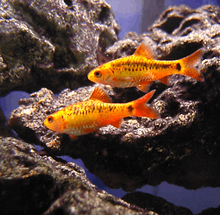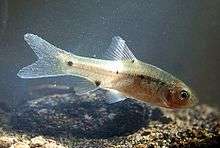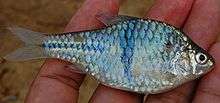Barbodes
| Barbodes | |
|---|---|
 | |
| Gold barbs (B. semifasciolatus var. schuberti) | |
| Scientific classification | |
| Kingdom: | Animalia |
| Phylum: | Chordata |
| Class: | Actinopterygii |
| Order: | Cypriniformes |
| Family: | Cyprinidae |
| Genus: | Barbodes Bleeker, 1859 |
| Type species | |
| Barbodes maculatus Valenciennes, 1842 | |
Barbodes is a genus of small to medium-sized cyprinid fish native to tropical Asia. The majority of the species are from Southeast Asia. Many species are threatened and some from the Philippines are already extinct.[1] Several members of this genus were formerly included in Puntius instead.[2]
Etymology
The name is derived from the Latin word barbus, meaning "barbel", and the Greek word oides, meaning "similar to".


.jpg)
Species
There are currently 48 recognized species in this genus:[2][3]
- Barbodes amarus Herre, 1924 (Pait)
- Barbodes aurotaeniatus (Tirant, 1885)
- Barbodes banksi (Herre, 1940)
- Barbodes baoulan Herre, 1926 (Baolan)
- Barbodes binotatus (Valenciennes, 1842) (Spotted barb)
- Barbodes bovanicus (F. Day, 1877) (Bowany Barb)
- Barbodes bunau (Rachmatika, 2005)
- Barbodes cataractae (Fowler, 1934)
- Barbodes clemensi Herre, 1924
- Barbodes disa Herre, 1932
- Barbodes dorsimaculatus (C. G. E. Ahl, 1923) (Blackline barb)
- Barbodes dunckeri (C. G. E. Ahl, 1929) (Bigspot barb)
- Barbodes elongatus (Ōshima, 1920)
- Barbodes everetti (Boulenger, 1894) (Clown barb)
- Barbodes flavifuscus Herre, 1924 (Katapa-tapa)
- Barbodes hemictenus D. S. Jordan & R. E. Richardson, 1908
- Barbodes herrei (Fowler, 1934)
- Barbodes ivis (Seale, 1910)
- Barbodes jacobusboehlkei (Fowler, 1958) [4]
- Barbodes joaquinae (C. E. Wood, 1968)
- Barbodes katolo Herre, 1924
- Barbodes kuchingensis (Herre, 1940)
- Barbodes lanaoensis Herre, 1924 (Kandar)
- Barbodes lateristriga (Valenciennes, 1842) (Spanner barb)
- Barbodes lindog Herre, 1924 (Lindog)
- Barbodes manalak Herre, 1924 (Manalak)
- Barbodes manguaoensis (A. L. Day, 1914)
- Barbodes microps (Günther, 1868)
- Barbodes montanoi (Sauvage, 1881)
- Barbodes pachycheilus (Herre, 1924)
- Barbodes palaemophagus (Herre, 1924)
- Barbodes palata Herre, 1924
- Barbodes palavanensis (Boulenger, 1895)
- Barbodes polylepis J. X. Chen & D. J. Li, 1988
- Barbodes quinquemaculatus (Seale & B. A. Bean, 1907)
- Barbodes resimus (Herre, 1924)
- Barbodes rhombeus (Kottelat, 2000)
- Barbodes sealei Herre, 1933
- Barbodes semifasciolatus (Günther, 1868) (Chinese barb)
- Barbodes sirang Herre, 1932 (Sirang)
- Barbodes tras Herre, 1926
- Barbodes truncatulus (Herre, 1924) (Bitungu)
- Barbodes tumba Herre, 1924
- Barbodes umalii (C. E. Wood, 1968)
- Barbodes wynaadensis (F. Day, 1873)
- Barbodes xouthos (Kottelat & H. H. Tan, 2011)[5]
Note on species list: Kottelat 2013 states that B. dorsimaculatus may not be referable to this genus and considers it to be species inquirenda. He also implies that Barbodes should be restricted to Southeast Asian and Philippine endemics and that the following species from eastern and southern Asia may not be referable to this genus: B. bovanicus, B. carnaticus, B. elongatus, B. polylepis and B. wynaadensis. Because these species fall outside of the geographic area of his paper, their position in Cyprinidae is not addressed.[2]
References
- ↑ Ismail; Sampson; and Noakes (2014). The status of Lake Lanao endemic cyprinids. Environmental Biology of Fisheries 97(4): 425-434.
- 1 2 3 Kottelat, M. (2013): The Fishes of the Inland Waters of Southeast Asia: A Catalogue and Core Bibliography of the Fishes Known to Occur in Freshwaters, Mangroves and Estuaries. Archived December 2, 2013, at the Wayback Machine. The Raffles Bulletin of Zoology, 2013, Supplement No. 27: 1–663.
- ↑ Froese, Rainer, and Daniel Pauly, eds. (2013). Species of Barbodes in FishBase. October 2013 version.
- ↑ Kottelat, M. (2015): The fishes of the Nam Theun and Xe Bangfai drainages, Laos. Hydroécologie Appliquée, 19: 271–320.
- ↑ Kottelat, M. & Tan, H.H. (2011): Systomus xouthos, a new cyprinid fish from Borneo, and revalidation of Puntius pulcher (Teleostei: Cyprinidae). Ichthyological Exploration of Freshwaters, 22 (3): 209-214.